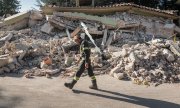How to make Italy quakeproof?
Accusations are flying after the earthquake in central Italy that claimed 290 lives because even buildings that were recently renovated now lie in ruins. Italy should take inspiration from Japan's building regulations, some commentators believe. Others call on Rome to make the country quakeproof without further increasing the debt ratio.
Follow Japan's example
The regions of Italy which suffered the most should learn from others that tightened their building regulations after similar disasters, The Malta Independent recommends:
“In nearby Norcia, which suffered from an earthquake in 1979, where the remaining buildings have been strengthened, hardly a house was affected this time round. The leaders in this are of course the Japanese, a country that is of very high seismic risk. After suffering from so many tragedies, buildings are now built according to a very high anti-seismic regulation and when an earthquake happens, people stop but then resume their lives as before. So, yes, do weep for the dead, but meanwhile use the lessons of science and technology to ward off such disasters.”
Don't sacrifice Stability Pact for reconstruction
The euro countries must stick to the stability pact in its current form despite the earthquake in Italy, the conservative daily Die Presse urges:
“Even before the earthquake Italian Prime Minister Matteo Renzi was calling for the principles of the Stability Pact to be thrown overboard. He wants to present a new debt-financed stimulus package even though Italy's debt-to-GDP ratio has already risen to 135.2 percent this year. ... Of all the EU states only Greece's debt ratio is higher. ... Italy must first of all push through reforms: why is mismanagement still rife in the banks? ... And the country is labouring under the weight of its overblown bureaucracy, which hinders investment. Perhaps if there was less corruption there would be fewer earthquake fatalities. It's no coincidence that experts have roundly criticised the quality of the buildings in the earthquake areas.”

